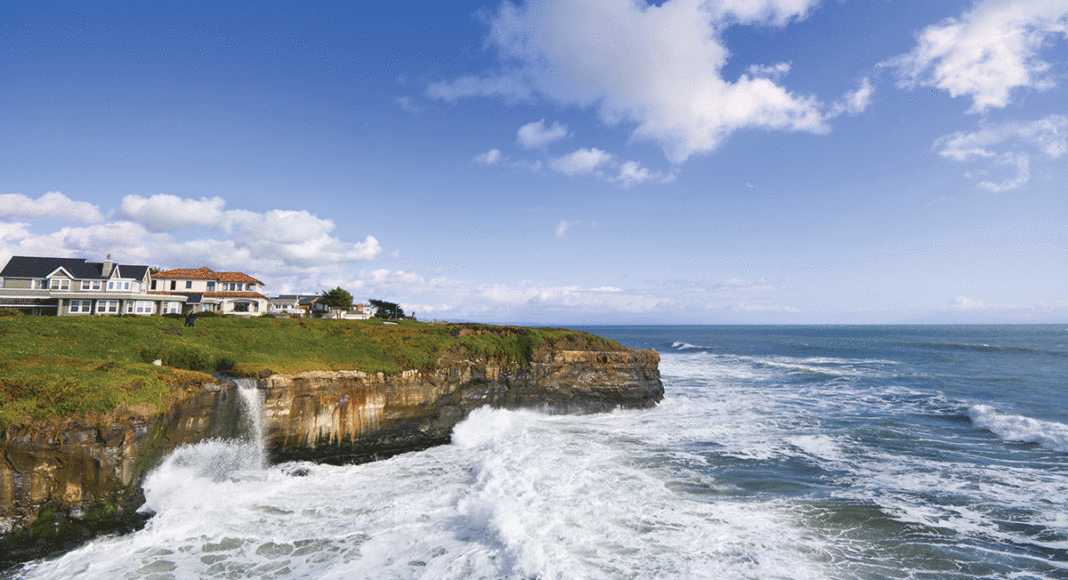Donna Meyers has a vision for Santa Cruz of walkable narrow green spaces that ribbon from one end of the city to another—along the coast, for instance.
“I like the idea of East Cliff and West Cliff and the river being linear parks,” says Meyers, who as chair of the Santa Cruz Parks and Recreation Commission is preparing for a joint study session with the City Council to look at the new Draft Parks Master Plan 2030.
City leaders have already created one linear park along the San Lorenzo River, but the idea of strengthening it and creating new ones along East Cliff and West Cliff drives has been inching forward. Councilmember David Terrazas, who served on the subcommittee to study for the Parks Master Plan, would like to see an official coastal park that stretches from Natural Bridges State Beach to the Santa Cruz Harbor.
“The question is: how do we make the most impact? This a tremendous opportunity to make linkages between downtown and the beach area that stretch the entire width and length of the city,” Terrazas says.
The master plan lays out a framework for how to meet the city’s recreation needs, and poses some interesting questions, like how to meet the needs of a town with a larger retired population than many other communities of the same size. To that end, Meyers has suggested installing more fitness areas at local parks with easy step-by-step instructions.
Another part of accommodating that population, says Parks Director Mauro Garcia, is in having a long list of seasonal recreational activities. He says city staffers will keep a close eye on new trends like pickleball, a racquet and net game played on special courts that’s soaring in popularity.
“It’s not as hard on one’s body [as tennis], but it still requires a lot of finesse,” Garcia says, adding that parks officials are also looking at places to add another ADA-accessible walking path, like the Arana Gulch Multi-Use Trail, which opened two years ago.
Santa Cruz’s pickleball community—readers will be forgiven for not previously knowing that such a group existed—has also been one of the most vocal groups in the master plan process, as they clamor for a dedicated facility to call their own. With dozens of tennis courts around the city, pickleballers normally lug their nets over to some tennis facilities at Sergeant Derby Park on the Westside a few days a week that they say were under-utilized.
The disagreements between pickleballers and tennis players—like any spat between paddle boarders and surfers—mostly boils down to a limited resource: turf.
The Santa Cruz County Board of Supervisors last November approved a $35,000 contract to retrofit some tennis courts at Brommer Park for pickleball. Terry Long, hardcore pickleball enthusiast, is hoping the city does something similar, perhaps at Derby Park.
“Pickleball is growing. And there are plenty other tennis courts on the Westside,” Long says. “Neary Lagoon has tennis Courts, Meder Street has tennis courts. Wrigley’s has tennis courts. UCSC has courts. Santa Cruz High has tennis courts on the weekends.”
The 216-page Draft Master Plan highlights a number of possible areas that could use funds, including courts for pickleball and tennis—which still dwarfs pickleball in terms of users, according to survey data included in the plan. It also identifies everything from trash cans and restrooms to community gardens to trails for hikers and mountain bikers, too.
Mountain bike lovers have stepped up and been the other vocal group at master plan meetings as they ask the city to consider new bike-only trails, which would have to go in either Pogonip or DeLaveaga Park.
It’s something Terrazas is receptive to, partly because the Emma McCrary Trail at Pogonip has been so successful and partly because the Mountain Bikers of Santa Cruz have partnered with the city in maintaining trails and proved entrepreneurial in raising funds. He suggests groups could use MBOSC as a model when looking for facilities.
Terrazas, perhaps the council’s most detail-oriented analyst, says overwhelming data in the master plan—the first for city parks in 40 years—will help guide greenspace decisions for years to come. He is personally excited about an idea buried in section three to have park rangers live onsite at community parks, allowing them to serve as hosts and caretakers while staying in workforce housing.
The draft plan calls for more hiking trails and a multi-use playing field, although staffers will have to examine all the possible site options in the future before deciding where any of that could go.
After the Feb. 7 evening study session, which starts at 7 p.m. in the City Council Chambers, the plan will go back to the Parks and Recreation Commission for about three more meetings. Then Garcia and parks staff will go to work on environmental documents and try to get the City Council a final version of the plan by the end of the year.
Part of the exciting challenge, Meyers says, is forecasting new trends.
“No one would have imagined mountain biking 50 years ago,” she says, “and then here it is today.”













